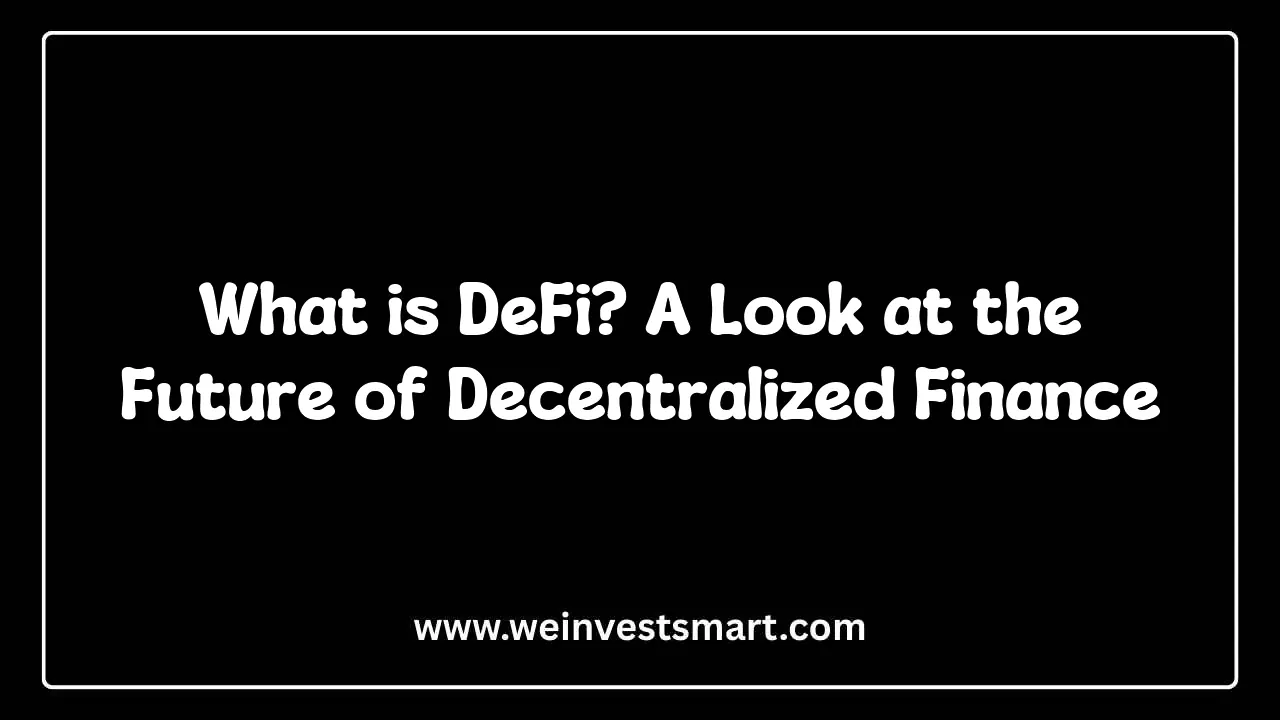· WeInvestSmart Team · technology · 9 min read
What is a Blockchain? A Simple Analogy You'll Actually Understand
Stop being confused by technical jargon. This article demystifies the core technology behind crypto using a single, powerful analogy: a shared, unchangeable digital notebook. Understand blocks, chains, decentralization, and transparency once and for all.
Most people believe that “blockchain” is one of those impossibly complex, futuristic terms that only computer scientists and crypto-fanatics can ever truly understand. They hear the word and their eyes glaze over, picturing a cascade of green code from The Matrix. It feels abstract, intangible, and frankly, a little bit like a solution in search of a problem. But here’s the uncomfortable truth: blockchain is arguably the most important invention since the internet itself, and it has almost nothing to do with complex code. At its core, it’s about a very human concept: trust.
For all of human history, when we’ve needed to agree on something important—who owns what, who paid whom, who voted for what—we’ve relied on a trusted middleman. A bank, a government, a lawyer. We give these central authorities the power to keep the official record, the one “true” ledger. But what if we didn’t need one? What if we could create a system where a group of people who don’t know or trust each other could create a single, shared source of truth that no one could corrupt?
Going straight to the point, that is what a blockchain does. It’s a machine for creating trust. And the funny thing is, you don’t need a PhD in cryptography to understand it. In fact, we can explain the entire revolutionary concept with a simple analogy you already know: a notebook.
The Foundation: Why We Need a New Kind of Notebook
Before we invent our magical notebook, we have to understand why the old one is broken. Imagine you and a group of nine friends go on a weekend trip. To keep things simple, you decide that only one person, let’s call her Claire, will be the “treasurer.” Claire keeps a single notebook that tracks all the money.
- Alice pays for dinner ($100). Claire writes it down.
- Bob buys the movie tickets ($50). Claire writes it down.
- At the end of the weekend, everyone looks at Claire’s notebook to settle up.
This is a centralized ledger. Claire is the bank, the single source of truth. But what are the problems here?
- Single Point of Failure: What if Claire loses the notebook? The entire record is gone forever.
- Trust is Required: You have to trust that Claire is honest. What if Bob is Claire’s best friend, and she secretly erases one of his debts?
- Lack of Transparency: No one can see the notebook until Claire decides to show it to them.
- Censorship: What if Claire doesn’t like Alice and refuses to record her transactions?
This, in a nutshell, is how our entire financial and legal system works today. We rely on centralized “Claires” to manage our most important records. Blockchain was invented to fire Claire.
The Analogy: The Magical, Shared, Unchangeable Notebook
Now, let’s reinvent the system. Instead of giving the notebook to one person, what if we gave every single one of the ten friends an identical copy of the notebook? And what if these notebooks were magical—as soon as someone wrote a new entry in their notebook, it instantly and automatically appeared in everyone else’s notebook?
Here’s where things get interesting. We have just invented the core of a blockchain. This is decentralization. There is no “master copy.” The official record, the single source of truth, is the one that is held and agreed upon by the entire group. There is no Claire. The network is the treasurer.
But what do we do with this? How do we add new transactions and, more importantly, how do we stop people from cheating? This is where the magic really begins.
Step 1: Making an Entry (A Transaction)
Let’s say Alice wants to pay Bob $20. She can’t just quietly write it in her own notebook. Instead, she has to announce it to the entire group.
She shouts, “Attention everyone! I, Alice, am sending $20 to Bob! Please add this to your notebooks!”
Step 2: Verifying the Entry (Validation)
Before anyone writes this down, every single person in the group performs a quick check. They look through their own copy of the notebook to answer two simple questions:
- Does Alice actually exist in our system?
- More importantly, does Alice have at least $20 to send?
If Alice has the funds, everyone gives a thumbs-up. If she doesn’t, the group collectively ignores her request. This validation process, performed by the majority of the network, prevents anyone from spending money they don’t have.
Step 3: Grouping the Entries (The “Block”)
It would be inefficient to stop and get group consensus for every single transaction. So, the group agrees to bundle them. They wait until they have a handful of verified transactions—Alice pays Bob $20, Charlie pays David $10, etc.—and gather them together on a fresh, new page of the notebook.
This page, full of verified transactions, is a Block.
Step 4: Sealing the Page (The “Chain”)
This is the most important step. How do we ensure that once a page is added to the notebook, no one can ever go back and secretly change it? How do we make the notebook’s history permanent and unchangeable?
We do it by making it incredibly difficult to add a new page. The group sets a rule: “To earn the right to add the next official page of transactions to our notebooks, you must be the first person to solve an extremely difficult math puzzle.”
This puzzle is complex to solve but very easy for everyone else to verify. This process is called Proof-of-Work. Thousands of computers on the network are all racing to find the solution. The winner gets to add the next block of transactions and often receives a small reward for their effort (this is how new bitcoins are “mined”).
But here’s the truly ingenious part. The math puzzle for the new page (Block #101) is cryptographically linked to the previous page (Block #100). The unique solution to Block #100’s puzzle becomes a part of the puzzle for Block #101.
This creates a digital seal, connecting each page to the one before it, forming an unbreakable Chain.
And this is just a very long way of saying that the past is cryptographically baked into the present. To secretly change a transaction on Page 50, you would have to break its seal. But that seal is part of the puzzle for Page 51, so you’d have to break that seal and re-solve its puzzle. Which is part of the puzzle for Page 52, and so on, all the way to the most recent page. You would have to redo all that computational work, for every single subsequent block, faster than the entire global network is adding new ones.
What is a Blockchain FAQ
What is blockchain technology?
Blockchain is a decentralized digital ledger that records transactions across multiple computers securely and transparently.
How does blockchain work?
Blockchain works by grouping transactions into blocks, validating them through consensus, and linking blocks in a chain using cryptography.
What are the benefits of blockchain?
Benefits include decentralization, transparency, immutability, security, and reduced intermediaries.
What are some real-world applications of blockchain?
Applications include cryptocurrencies, supply chain management, voting systems, and smart contracts.
Is blockchain secure?
Yes, blockchain is secure due to cryptographic hashing, decentralization, and consensus mechanisms that make it hard to alter data.
This is practically impossible. It would require more computing power than exists in most countries. It makes the history of the notebook effectively immutable. It’s set in digital stone.
The Properties of Our Magical Notebook
So, by creating this system, what have we achieved? Our shared notebook—our blockchain—now has four incredible properties that a normal, centralized notebook lacks:
- It’s Decentralized: There is no single point of control or failure. The notebook is held by everyone, so it can’t be lost, and its operation doesn’t depend on any single person or company. To shut it down, you’d have to shut down every single computer on the network simultaneously.
- It’s Transparent: Every member of the group can see the entire history of all transactions ever made. This creates a radical level of auditability. (Note: On public blockchains like Bitcoin, this is pseudonymous—your real-world identity isn’t tied to your address, but all transactions are public).
- It’s Immutable: Thanks to the cryptographic chain of sealed pages, once a transaction is confirmed by the network and added to a block, it is practically impossible to alter or remove.
- It’s Secure: Because the system is decentralized and relies on cryptographic proof, you don’t need to trust any individual participant. You only need to trust the code and the mathematics that govern the system. We’ve replaced the need for trusting people with the certainty of trusting math.
What a Blockchain is NOT
Understanding the analogy also helps us debunk common myths.
- A blockchain is NOT just Bitcoin. Bitcoin was simply the first application ever built using blockchain technology. It’s like saying “the internet is just email.” The internet is the underlying network that allows for countless applications like email, the web, streaming video, and more. Similarly, blockchain is the underlying technology that allows for countless applications like Bitcoin, Ethereum, supply chain management, and digital identity systems.
- A blockchain is NOT just a database in the cloud. This sounds like a trade-off, but it’s actually a desirable thing. A normal database (like the one your bank uses) is designed to be fast and easy to edit by its owner. A blockchain is deliberately designed to be slow and extremely difficult to edit by anyone. Its inefficiency is the source of its security. You would never use a blockchain to run a high-speed social media app, but you would use it to secure a nation’s land titles.
- A blockchain is NOT free. The “Proof-of-Work” system of solving puzzles requires an immense amount of computational energy. This energy expenditure is what secures the network and makes it so hard to attack. It’s the price of decentralized, trustless security.
The Bottom Line: A New Foundation for an Old Idea
The formula for this revolution is surprisingly simple: (Decentralized Network + Transparent Ledger + Cryptographic Security) = Trust without a Trustee
You can’t control the banks. You can’t control the governments. But with a public blockchain, you have a system whose rules are transparent and whose history is unchangeable, all governed by mathematics instead of the whims of a powerful few.
And this is just a very long way of saying that blockchain is a technology that manufactures trust. It’s a tool that allows large groups of uncoordinated strangers to cooperate and agree on a shared reality without needing to elect a ruler or trust an intermediary. This is a fundamentally new way to organize human activity. It started with reinventing money, but its potential extends to reinventing voting, supply chains, art ownership, and the very fabric of the internet itself. For the first time, we have a notebook that we can all write in together, but that no single one of us can ever erase.
This article is for educational purposes only and should not be considered personalized financial advice. Consider consulting with a financial advisor for guidance specific to your situation.



